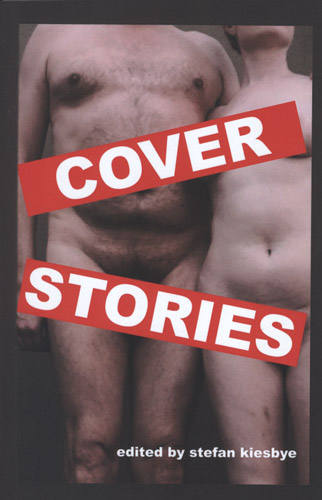Cover Stories
Writer and editor Stefan Kiesbye believes that “every story leaves a multitude of stories untold.” He acted on this idea by inviting fifteen writers to each choose a favorite story, then write a cover for it. The resulting anthology is appropriately titled Cover Stories. Most of the favorites were pulled from the past, but contemporary writer ZZ Packer also made the list.
Writer and editor Stefan Kiesbye believes that “every story leaves a multitude of stories untold.” He acted on this idea by inviting fifteen writers to each choose a favorite story, then write a cover for it. The resulting anthology is appropriately titled Cover Stories. Most of the favorites were pulled from the past, but contemporary writer ZZ Packer also made the list.
“There’s no way to cover ZZ Packer’s ‘Brownies,’ for me, except very broadly to honor the premise of kids operating under a misunderstanding,” writes Jane Dykema about her tale, “Luna Beach.” Dykema’s narrator Louisa and her brother Ricky were warned as children never to go to Luna Beach because it was a hive of drug runners. Kids being kids, they can’t resist. They persuade an adult friend to buy them a drone so they can spy on the bad guys, an adventure that produces unexpected results.
Derek Nikitas demonstrates the variety of the anthology by going in a different direction with his creepy story titled, “The Call.” Nikitas notes that he lives “not far from Lovecraft’s old haunts,” so it was a natural for him to select H.P. Lovecraft’s “Cthulhu” as a starting point. The narrator, Professor Angell, tells about the death of his son, Scott, in macabre detail. Climbing the spiral staircase to Scott’s apartment, he “smelled sulfur and collapsed in the doorway at the sight of what awaited me just over the threshold: blood spilled across the floor, severed organs in ritual arrangement . . . .”
Some of the contributors chose to use the same character names as those appearing in the stories they cover. Among them, “Craigslist Missed Connections,” by Alexander Lumans, takes on Flannery O’Connor’s “The Life You Save May Be Your Own.” In O’Connor’s piece, a woman strives to marry off her deaf and mute daughter Lucynell to a tramp named Shiftlet. Lumans modernizes the story by having his Lucynell, who also can’t hear or speak, place Craigslist ads looking for the tramp named Shiftlet she wants to reconnect with. Each message ends with some form of the wishful request: “Reply with [ . . . ] so I’ll know it’s really you,” mimicking the format of real missed connection ads, a creative take.
Brian Evenson, in “The Other Neighbors,” borrows the names of couples Jim and Harriet and Bill and Arlene from Raymond Carver’s “The Neighbors,” but he flips the script, showing the story from the point of view of the opposite set of neighbors as Carver. As Evenson’s Bill and Arlene slowly invade the lives of Jim and Harriet, Jim notices, “a bottle of my pills were gone—nothing I needed, and expired, but still. [ . . . ] Plus, there was a brown and shriveled apple core under the nightstand, and someone had taken two bites out of the cheddar in the fridge. I mean who the hell does that?”
As you can see, humor pokes its way into the book. Jessica Anthony’s “Dear Stranger” selected Edgar Allen Poe’s “The Tell-Tale Heart” to cover, but she doesn’t stop there. She uses sketches and an assortment of fonts to jazz things up. Translated here into a less zany font, one of her lines reads: “During the night, I woke up. I heard these strange ‘puh-puh’ sounds. Your heart was snoring.”
Cover Stories turns out to be the perfect vehicle for someone to parody Isaac Babel’s famous story, “The Nose.” Jeff Parker does it rather hilariously in “The Penis.” A quick recap of Babel’s story: A man wakes up to discover his nose has vanished, and said nose then comes alive with human qualities. Parker relocates his piece from St. Petersburg, Russia, to the St. Petersburg, Florida, home of Daria and her wife Jenny. Daria begins cutting her loaf of breakfast bread and “to her surprise, saw something. [ . . . ] She stuck in her fingers and pulled out—a penis! and, what’s more, it seemed like a familiar one.”
Not to be outdone, Stefan Kiesbye, who edits this collection, includes a story with the same title as Jack London’s “To Build a Fire.” He veers from London’s story of a man who foolishly ventures into the Yukon wilderness, and focuses instead on a married couple who appear to have just as foolishly bought a house beyond their means. Their solution to the exhausting chore of unpacking? “We’re just going to leave the garage door open,” she said. “People will start taking things. Boxes will disappear. At first they’ll take the bikes, the lawn mower. Then the wardrobes will be gone. They won’t leave anything behind.” Next, they leave the doors open, and yes, as in both stories, there is a fire.
The exceeding entertaining pieces in Cover Stories can easily stand on their own. But don’t stop there. At the end of the book, you’ll find the originals these writers selected as starting points. If you’re not familiar with them, do the research for a double dose of fun and erudition.





